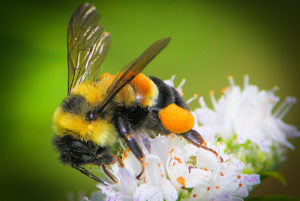14
Feb
Trump Administration Reverses Endangered Species Designation for Bumblebee Pending Review
(Beyond Pesticides, February 14, 2017) Less than one month after the Rusty Patched Bumblebee’s listing as ‘threatened’ under the Endangered Species Act (ESA) by the U.S. Fish and Wildlife Service (FWS), the Trump Administration has reversed the order. On his first day in office, President Trump issued a memo instructing federal agencies to postpone the effective date of any regulations that had been published in the Federal Register, but not yet in effect. This order means that despite FWS’ determination that without federal action the species will likely become endangered, the Trump administration has 60 days to evaluate the decision for the purpose of “reviewing questions of fact, law, and policy.”
Advocates for the imperiled species are urging the administration to allow the Rusty Patched Bumblebee to officially become the first bumblebee federally recognized under ESA. Although the Rusty Patched was once widespread  throughout the United States and parts of Canada, it declined dramatically in the 1990’s, and now their populations are estimated to be less than 10% of what they once were. On its website, FWS lists a number of threats to the Rusty Patched, including pesticides, habitat loss, disease, climate change, and intensive farming practices.
throughout the United States and parts of Canada, it declined dramatically in the 1990’s, and now their populations are estimated to be less than 10% of what they once were. On its website, FWS lists a number of threats to the Rusty Patched, including pesticides, habitat loss, disease, climate change, and intensive farming practices.
Insecticides known as neonicotinoids, introduced into chemical-intensive agricultural practices in the late 1990s, have seen use increase significantly over the last several decades, to the detriment of both managed and wild pollinator populations. These chemicals been implicated as a key contributor to the recent global decline in pollinator diversity. Neonicotinoids affect the central nervous system of insects, resulting in paralysis and eventual death. When they do not result in acute toxicity and immediate death, sublethal exposure causes changes in bee reproductive, navigation, and foraging ability. Neonicotinoid exposure impairs both detoxification mechanisms and immune responses, rendering bees more susceptible to viruses, parasites, and other diseases, and leading to devastating bee losses.
When asked by NBC News, the U.S. Department of Interior did not immediately respond whether the Rusty Patched Bumblebee’s status under the new administration would change. Despite the Obama Administration’s lackluster efforts to address the root cause of pollinator decline, and opt for a strategy that includes additional research and a focus on habitat, the administration did give a platform for pollinator protection efforts at the Presidential level. A revocation will be met with intense criticism by environmental groups, as it would be seen as a gift to special interests like the American Farm Bureau Federation, which promotes pesticide use. The Farm Bureau told NBC news that it opposed the Rusty Patch listing and that ESA “imposes far-reaching regulatory burdens.”
While attacks against ESA listings are likely to become more frequent over the next several years, it is critical that consumers are educated on the importance of wild pollinators, both to agricultural productivity and for their intrinsic value. Indeed, there is a strong argument that it would cost more to not protect species like the Rusty Patch than to allow them to go extinct. A 2016 UN report warning of shortages in global food supplies should pollinator numbers decline any further estimates that pollinators worldwide contribute between $235 and $577 billion in agricultural productivity annually. In addition to their value in dollars, every species is like a book in the library of life, and losing a species is like burning that book. It means we will forever miss out, and never truly understand how its story connects with the chronicles of life on Earth.
Help Beyond Pesticides show appreciation for both wild and managed pollinators by taking local action. Get involved at the community level to pass policies that protect imperiled pollinators. Right now, without federal protection, the Rusty Patched Bumblebee needs concerned communities throughout the country to step in and makes changes that give it a fighting chance. Use our resources and educational materials, including our BEE Protective doorknob hangers to get the word out. And be sure follow Beyond Pesticides’ ongoing series celebrating unsung wild pollinator heroes through the Polli-NATION campaign.
Source: NBC News
All unattributed positions and opinions in this piece are those of Beyond Pesticides.










